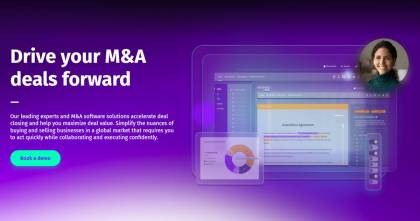Companies need a secure way to share financial reports, contracts and other important documents without the worry of information being accessed by the wrong party. A virtual data room meets the needs for security and privacy while offering many benefits for their users.
When you begin looking into virtual data rooms, one of the first things you may notice is the wide array of features on offer.
As a reminder, a virtual data room or VDR is a document storage repository used by businesses within finance, legal and other industries for mergers and acquisitions (M&As) and other deals. Read on to learn the top virtual data room features and how to pick a virtual data room that meets your needs.
10 Key Features of Virtual Data Rooms to Consider
Common data room features are offered by the major VDR partners. We’ve ranked top features with an explanation of each to help you make this important decision.
1. Security & Compliance
Security features should be top of mind when it comes to VDRs. Robust security features, including virus and malware scanning, multifactor authentication and advanced encryption provide peace of mind that uploaded data will stay safe.
Check whether the VDR partner meets third-party standards, such as those from SOC. These provide independent certification that a partner has taken action in line with industry-leading standards and offer valuable peace of mind.
2. Pricing/Cost Structure
VDR providers set the price for these solutions in different ways. The most common cost structures include:
- By GB of data used
- By number of users
- By number of pages/files stored
- Flat monthly fee
- Mixed plans that combine different cost structures
There is no best option. Rather, it’s a case of which option is best for your organization, which depends on the size of the company, frequency of deals and other variables.
3. Document Management
Document management refers to the options for uploading, organizing and working with documents. Common features in VDRs include:
- Drag-and-drop upload
- Bulk upload
- Robust search capability
- Tagging, labeling, or other categorizing features
- Multifile-format support, so documents do not need to be converted before uploading
4. Collaboration Tools
It takes a team to make a deal — not an individual. So too must your VDR support collaboration. Insist upon access control features that allow permissions to be set based on roles and responsibilities. This way, there is internal control over who sees what with statistics available to show who has viewed, saved, downloaded or printed a document.
On a related note, look for features such as redaction and watermarking that allow collaboration and sharing while safeguarding privacy and intellectual property.
5. Performance & Reliability
With any tech stack, performance and reliability data are key. Ask the partner about uptime, interruptions and delays. Then compare the data each partner provides to get an idea of the VDR's reliability as compared with similar products.
6. Ease of Use/Accessibility
The user experience of a VDR reflects how easy the software is to use. While a learning curve is to be expected with any new product, the best VDRs have features that make them accessible and easy to use.
A VDR needs to be accessible from multiple device types, including mobile devices. This allows parties to sign in from desktops, laptops, tablets and mobile phones and to enjoy the same feature-rich user experience. Most VDRs support mobile devices, so this should not be a feature you need to compromise on.
Beyond device type, the VDR should be intuitive. If the software is confusing, it will slow down the pace of due diligence and dealmaking.
Insist on a demo of the VDR solution to understand the workflows and core features included. After the demo, compare how the software would support or augment existing workflows. The right VDR for your organization will make it easy to complete processes without requiring unnecessary steps.
One final point on ease of use: No VDR is considered useful if it cannot be fully used by the team. Make sure that the languages spoken by your team are supported by the VDR; many offer multilingual support.
7. Reporting & Analytics
Companies aren’t one-size-fits-all; the same should hold true for reporting and analytics options. Insist upon a virtual data room that allows administrators to configure various reports and access real-time analytics that provide the behind-the-scenes intelligence needed to keep things running smoothly.
Features to look for include:
- Project engagement analytics
- Buyer behavior analytics
- Document download and print statistics
- Track changes reporting
To go one step further, look at the customization features available for reports. Can data be color-coded for maximum visual impact? Can reports be formatted in different ways for presenting data during internal meetings? Is there at-a-glance reporting that provides the high-level overview C-suite execs need to stay informed while the deal proceeds?
8. Customization & Branding
First impressions matter when it comes to dealmaking. While it may seem like a nice-to-have, we believe that customization options are important for this reason. Customizing a VDR with corporate branding, including logo and color palette, not only personalizes the experience, but also it enhances the professionalization for all involved parties.
9. Integration
The best VDR is of no use to your organization if it does not integrate with the other software your team uses. As you narrow down VDR partners, double-check their VDR solution fully integrates with the other products in your organization’s tech stack.
10. Expert Support
Deals don't run on a 9 to 5 clock, and neither should your virtual data room. Best-in-class VDR providers support dealmaking with 24-7 customer support that is multilingual. They go above and beyond by providing a dedicated project manager to support its clients.
Reading this list of important features of virtual data rooms to consider, what stands out to you?
Chances are the most important features of data room organization will reflect the makeup of your team, business niche and most frequent type of deals.
Understanding your organization’s unique needs and these top features, you can approach VDR partners with a better understanding of the must-have features in the right virtual data room solution for your business.


